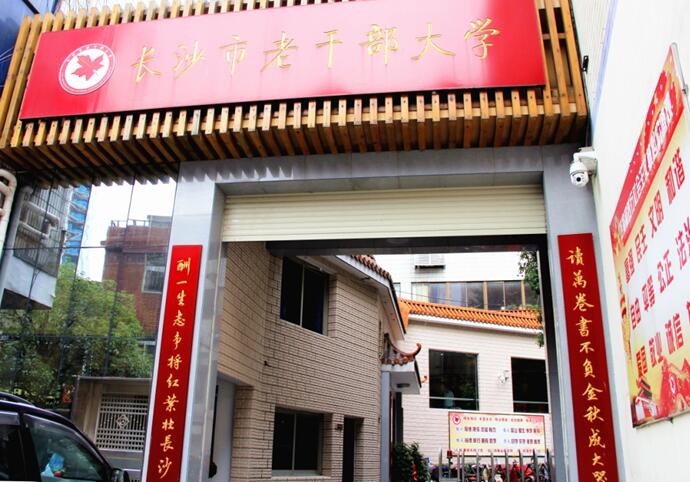
湖南长沙
 简介
简介
湖南长沙市老干部大学 Changsha U3A, Hunan

长沙市老干部大学一校两部。本部坐落在省会长沙中心繁华地段的五一大道和蔡锷中路交汇处,约6200平方米,分部在长沙市老干部活动中心,约800平方米。是一所多学科、多层次、综合性的现代化老年教育学府。学校始办于1987年,曾因场地建设一度停办,后于1999年恢复办学至今。
学校现有教学场地4800平方米,2017年内增至6200平方米,学员16000余人次。学校设有文史、保健、音乐、舞蹈、书画、综合等6个系;设有课程73门,现每学年班级逾192个。学校内设教务处、教研室、办公室三个科室,有管理人员20余名,教师80余名。学校在市委市政府的亲切关怀和市委老干部局的正确领导下,秉持“厚德、康乐、求知、有为”的校训,采用“老领导管校、专家治校、名师执教、学员自治”的管理模式。
Introduction to Changsha U3A in Hunan Province
Changsha U3A has two campus. Its headquarter is located at the intersection of Wuyi Avenue and Caiezhong Road in the bustling area of the Changsha center of the provincial capital for about 6200 square meters, and its division is at the Activity Center of the retired officers in Changsha for about 800 square meters. Established in 1987, once closed because of field construction and re-established in 1999, it is a multi-disciplinary, multi-level and comprehensive modern educational institution for the aged.
The university has teaching space of 4,800 square meters, which increased to 6200 square meters in 2017, and more than 16,000 students. It has 6 departments including literature and history, healthcare, music, dance, calligraphy and painting, and comprehensive learning with 73 courses and more than 192 classes in each school year. There are three offices, namely, the academic affairs office, the teaching and research office and the administration office with more than 20 managerial personnel and 80 teachers. Under the cordial care of the municipal government and the correct leadership of Municipal Bureau of Veteran Cadres, the university holds fast to the motto of "great virtue, health and happiness, seek knowledge and become successful" and adopted the management mode of "old leadership and management, expert management, master teacher teaching and student autonomy".
2.长沙市老干部大学特色游学内容展示
A.湖南长沙民俗文化
(1)长沙三绝
长沙三绝指的是湘绣之美、菊花石刻之奇、棕编之巧。湘绣是我国四大名绣之一,繁复华丽;菊花石刻工艺精湛,惟妙惟肖;棕编极具长沙风情,称其一绝。
(2)中国红瓷器
中国红瓷器最早出现于1100年前的晚唐长沙窑,釉色为纯正的大红色,虽中间此技艺一度失传,但1998年底,尹彦征在长沙才研制出纯正的红瓷器,并在长沙隆平高科技园建立了中国红陶瓷工艺园。
(3)花鼓戏
2008年,花鼓戏入选第二批国家级非物质文化遗产名录。通常所见到的湖南花鼓戏经典剧目《刘海砍樵》、《打铜锣》、《补锅》实为代表湖南花鼓戏的长沙花鼓戏中的剧目。
(4)美食文化
长沙美食种类丰富,口味多变。湘菜作为中国八大菜系之一,早在汉朝就已经形成。同时,长沙的小吃也令人赞不绝口,常见的有口味虾、长沙臭豆腐、糖油粑粑、黄鸭叫、德园包子、长沙米粉等等。
B.湖南长沙红色文化
长沙是我国红色文化的聚居地之一,中华人民共和国开国领袖毛泽东便出生于此。长沙不仅保留了中国政党当时珍贵的历史资料,同时也记载了中华民族不断奋斗的道路历程。重要的红色文化景点有:“中共湘区委员会旧址”清水塘、湖南自修大学旧址船山学社、湖南省立第一师范、新民学会旧址等。
C.湖南长沙自然风光
(1)岳麓山
岳麓山风景区位于湖南省长沙市长沙市湘江西岸,依江面市,海拔300.8米,占地面积35.20平方公里,是南岳衡山72峰的最后一峰,为城市山岳型风景名胜区,是中国四大赏枫胜地之一,为世界罕见的集“山、水、洲、城”于一体的国家AAAAA级旅游景区、国家重点风景名胜区、湖湘文化传播基地和爱国主义教育的示范基地。
(2)橘子洲
橘子洲风景区位于湖南省长沙市市区对面的湘江江心,是湘江中最大的名洲,由南至北,横贯江心,西望岳麓山,东临长沙城,四面环水,绵延数十里,狭处横约40米,宽处横约140米,形状是一个长岛,是国家重点风景名胜区。
D.湖南长沙历史文化
(1)湖南省博物馆
湖南省博物馆占地面积4.9万平方米,总建筑面积为9.1万平方米,筹建于1951年,1956年正式对外开放,藏品达18万余件,尤以马王堆汉墓文物、商周青铜器、楚文物、历代陶瓷、书画和近现代文物等最具特色,并以此打造了6个展示人类优秀文化遗珍的基本陈列。
(2)贾谊故居
贾谊故居始建于西汉文帝年间,即公元前177年至公元前174年,西汉著名政论家、思想家和文学家贾谊住在这里,时任长沙王太傅。在长沙,贾谊撰写《吊屈原赋》、《鸟赋》,奠定了他在中国文学史上的重要地位,故后人称其为“贾长沙”,故宅被誉为长沙最古的古迹及湖湘文化的源头。
(3)长沙简牍博物馆
长沙简牍博物馆是目前世界唯一一座集简牍收藏、保护、整理、研究和陈列展示于一体的新型现代化专题博物馆,也是长沙一个重要的文化景点和对外开放窗口。本馆占地30亩,主体建筑面积14100平方米,其中展厅面积6000平方米,库房面积3000平方米。本馆简牍藏品主要为1996年出土的14万枚三国孙吴时期纪年简牍和2003年发现的2万余枚西汉初年纪年简牍,另外,青铜漆木书画金银等其它藏品约3500件。
1. The Characteristic content of study tours display of Changsha U3A
A. Folk Culture in Changsha, Hunan province
(1) Three Uniques of Changsha
“Three Uniques of Changsha” refers to beautiful Xiang embroidery, rare chrysanthemum stone carving and artful brown knitting. Xiang embroidery is one of China's four famous embroiderers, which is gorgeous and magnificent. The art of chrysanthemum stone carving is exquisite and vivid. Brown knitting presents a Characteristic Changsha style, making it one of the Uniques.
(2) China Red Porcelain
China red porcelain first appeared in Changsha kiln before 1100 in the late Tang Dynasty , and the glaze was pure red. Although the art of making it was once lost, Yin Yanzheng developed the pure red porcelain in Changsha at the end of 1998 and established the Chinese Red Ceramic Craft Garden in Longping high-tech park in Changsha.
(3)Flower-drum Opera
In 2008, Flower-drum Opera was included in the second batch of national intangible cultural heritage list. The classic Flower-drum Opera in Hunan, such as "Woodcutter Liu Hai", "playing gong" and "repairing pot" are actually the repertoire of the Changsha Flower-drum Opera, a represent of Hunan’s.
(4)Food Culture
Changsha has a rich variety of food with many flavors. As one of the eight major cuisines of China, Hunan cuisine was formed in the Han Dynasty. In addition, Changsha's snack is beyond praise, among which the common ones are Shrimp Taste, Changsha Stinky Tofu, Sugar oil BaBa, Pelteobagrus fulvidraco, Tak Park baozi, Changsha-style rice vermicelli, etc.
B. Red Culture in Changsha, Hunan province
Changsha is one of localities for the red culture in China where Mao Zedong, the founder of People's Republic of China, was born. Changsha not only retained the precious historical data of Chinese political parties, but it also recorded the course of the Chinese nation's continuous struggle. It has the following major attractions: Qingshui Pond ("the old site of the Committee of the Communist Party of China in Hunan"), Chuanshan Institute (old site of Hunan Seld-study University), the first normal school of Hunan, the old site of the New People's Society.
C. Natural scenery in Changsha, Hunan province
(1) Yuelu Mountain
Located in the west bank of Xiang river in Changsha, Hunan province, Yuelu Scenic Spot is close to the river and faces the city. Covering an area of 35.2 km2 with an altitude of 300.8m, it is the last peak of the 72 peaks of the Heng Mountain. As a urban mountain-type scenic spot, it is also one of the four most famous scenic spots for maple appreciation in China. Integrating “water, mountain, islet and city”, Mt. Yuelu scenic spot is the national AAAAA scenic area, the national key scenic spot, Hunan culture spreading base and patriotic education base.
(2) Orange Isle
Lying in the middle of Xiangjiang river, orange Isle is the world’s longest inland river isle. Surrounded by water, it goes across the heart of the river from south to north, faces the Mount Yuelu in the west and is next to Changsha city in the east. It stretches dozens of miles long with about 40m across the narrow side, 140m across he wide side to form a shape like a long island. It is a national key scenic spot.
D. History and Culture in Changsha, Hunan province
(1) Hunan Provincial Museum
Covering an area of 49,000 km2 with the total gross floor area of 91,000 km2 , was schemed in 1951 and officially opened in 1956. It incorporates more than 180,000 collections, featured by Mawangdui Han Tombs, bronze wares in Shang and Zhou dynasties, Chu artifacts, ancient ceramics, paintings and modern cultural relics, etc., and six basic exhibitions are created to display outstanding human cultural treasures.
(2) Jia Yi's Former Residence
In the reign of the Learned Emperor of West Han Dynasty between 177 BC and 174 BC, Jia Yi’s former residence was founded, when Jia Yi, a famous critic, ideologist and writer of West Han Dynasty, lived and worked as a grand mentor in Changsha. In changsha, he wrote Mourn for Quyuan, Ode to the bird, which helped establish his important position in the history of Chinese literature so he was named “Jia Changsha” by the descendants and his former residence was honored as the source of the most ancient monuments of Changsha and Hunan culture.
(3) Inscribed Bamboo Slips Museum of Changsha
Inscribed Bamboo Slips Museum of Changsha is the only new and modern thematic museum integrating the collection, protection, organization, research and display of inscribed bamboo slips in the world as well as a major cultural attraction and the channel for opening-up. The museum covers an area of 30 acres, the main building area of 14,100 km2, of which the exhibition hall accounting for 6,000 km2, warehouse 3,000 km2. The museum has the following main collections: the 140,000 pieces of the chronological slips of three countries during the Sun-Wu period unearthed in 1996 and the 20,000 pieces of the chronological slips of the Western Han Dynasty discovered in 2003. In addition, other collections such as 3,500 pieces of bronze-lacquered wood and gold and silver are also included.






